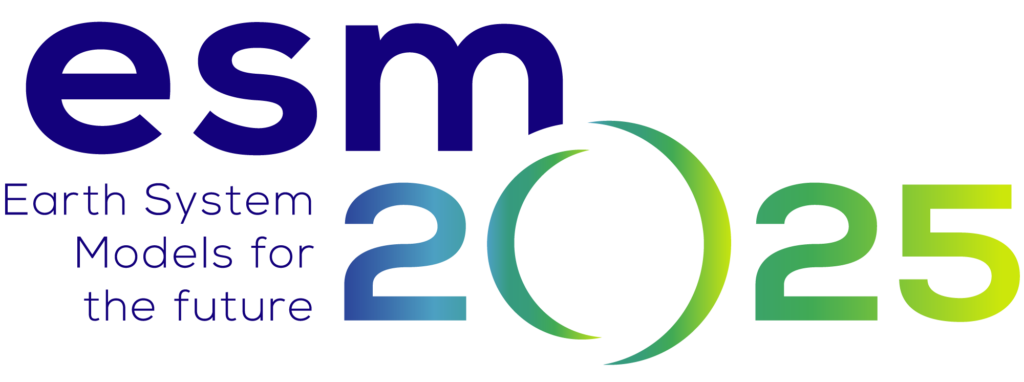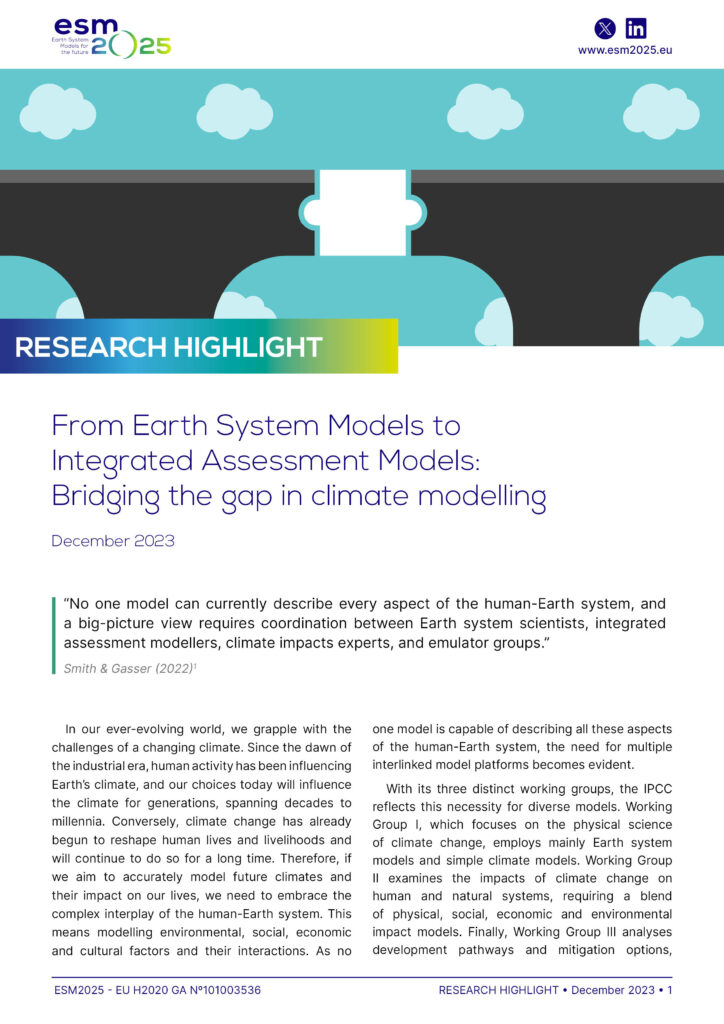
“No one model can currently describe every aspect of the human-Earth system, and a big-picture view requires coordination between Earth system scientists, integrated assessment modellers, climate impacts experts, and emulator groups.”
Smith & Gasser (2022)
In our ever-evolving world, we grapple with the challenges of a changing climate. Since the dawn of the industrial era, human activity has been influencing Earth’s climate, and our choices today will influence the climate for generations, spanning decades to millennia. Conversely, climate change has already begun to reshape human lives and livelihoods and will continue to do so for a long time. Therefore, if we aim to accurately model future climates and their impact on our lives, we need to embrace the complex interplay of the human-Earth system. This means modelling environmental, social, economic and cultural factors and their interactions. As no one model is capable of describing all these aspects of the human-Earth system, the need for multiple interlinked model platforms becomes evident.
With its three distinct working groups, the IPCC reflects this necessity for diverse models. Working Group I, which focuses on the physical science of climate change, employs mainly Earth system models and simple climate models. Working Group II examines the impacts of climate change on human and natural systems, requiring a blend of physical, social, economic and environmental impact models. Finally, Working Group III analyses development pathways and mitigation options, employing integrated assessment models, which provide “an integrated view of the global energy-economy-climate-land system”. The intersection of these working groups highlights the value of diverse model platforms in comprehending the human-Earth system’s complexity. By leveraging specialised models within each working group, we can develop a holistic perspective, and shed light on the dynamic and evolving nature of our connection to the planet. Only through the collaborative effort of multiple model platforms, as exemplified by the IPCC, can we hope to paint a comprehensive picture of the human-Earth system, enabling us to make informed decisions for a sustainable future.
A DIVERSITY OF MODELS
In line with the WCRP vision of a ‘model multiverse’, the research work carried out in the scope of ESM2025 includes three different types of models: Earth System Models (ESMs), Simple Climate Models (SCMs) and Integrated Assessment Models (IAMs).
Earth System Models can be of varying complexity. They represent the physics of the atmosphere and the ocean (e.g., winds, clouds, ocean circulation), but can also simulate the interaction between the physical climate, the biosphere, and the chemistry of the atmosphere and the ocean. Hence, they include numerical representations of key global biogeochemical cycles, such as the carbon (C) and nitrogen (N) cycles, as well as representations of vegetation and land use, atmospheric chemistry, ocean ecology and continental ice sheets, with all of these processes interacting with each other. They can be driven by either scenarios of concentrations or emissions of greenhouse gases (in particular CO2). Such developments enable a more complete assessment of the full Earth system’s response to anthropogenic greenhouse gas (GHG) emissions and human land use.
Simple Climate Models (or reduced complexity and gas-cycle models), also known as climate emulators, provide a simplified representation of the Earth system. They “condense large-scale Earth system behaviour into a few equations and parameters that are informed by physical or statistical knowledge”. They are designed to rapidly emulate the response of a large ensemble of more complex ESMs under a range of climate scenarios and can produce a climate simulation in “a fraction of a second in a normal desktop”. Hence, they can rapidly be used to produce different climate responses with a number of runs sufficiently large to provide uncertainty estimates. Simple climate models are also routinely used in climate assessments to simulate a wide range of emission scenarios and to explore worst-case scenarios, as they are able to rapidly integrate multiple lines of evidence into their projections (such as theoretical or observational constraints).
Integrated Assessment Models are targeted policy models that simulate the dynamics of the global economy, energy and land-use systems and can include a simplified representation of the climate system (and potential feedbacks back onto the economy). They are used to generate future GHG emission scenarios and land use trajectories, as a function of different development pathways and societal choices. They are also used to explore the various climate policy and technology options. IAMs include a wide range of models, and can vary significantly in the way they work, their level of detail and structure, as well as the questions they are tailored to answer. For instance, some IAMs, which use highly simplified equations that do not model the detailed processes of the economy, energy and Earth systems, can be used to compare the costs and benefits of avoiding different levels of warming or calculate the ‘social cost of carbon’. However, for a more thorough analysis of how energy technologies, energy use choices, land-use changes and societal trends can influence GHG emissions, other more complex IAMs that combine a solid macroeconomic framework with high process detail of mitigation options are necessary.
The diversity of existing IAMs implies that they can be used for a variety of purposes, also beyond climate science. In this piece, we focus on the links between ESMs and IAMs (including the role of SCMs), which shape one of the main frameworks used for producing the data that feed IPCC assessments.
SSPs and the IPCC model chain
The Shared Socioeconomic Pathways (SSPs) define different plausible trends of how global society, demographics and economics might change over the twenty-first century. They were developed by an international team of climate scientists, economists and energy system modellers and are based on five narratives intended to span a range of plausible futures. Each baseline SSP “is an internally consistent, plausible and integrated description of a socio-economic future”, in the absence of climate change or new climate policies. Mitigation targets that set a target level of atmospheric GHG concentrations in 2100 (defined by radiative forcing levels) can then be combined with each SSP to examine how different levels of climate mitigation and adaptation could fit into each future scenario. The SSPs are thus an important input for climate models but are also used to explore how societal choices can affect greenhouse gas emissions.
For the IPCC Sixth Assessment Report, six different IAMs (AIM-CGE, GCAM, IMAGE, MESSAGE-GLOBIOM, REMIND-MAgPIE and WITCH-GLOBIOM) were used to provide a unique translation of the SSP narratives into scenarios of energy use, air pollution control, land use, and GHG emissions. The simple climate model MAGICC was then used to convert GHG emissions from the IAMs into GHG atmospheric concentrations and future warming. This process was repeated with other SCMs, such as FaIR, to ensure robustness. The SSP scenarios were subsequently employed to drive ESMs with emission or concentration data for GHGs, aerosols and land-use or land cover maps. Since not all IAMs have performed all SSPs, no proper estimate of the model uncertainty in the emission and land-use patterns can be derived from these models. ESMs can then generate climate projections consistent with each emission scenario, along with resulting climate impacts, and the assessment of potential mitigation strategies.
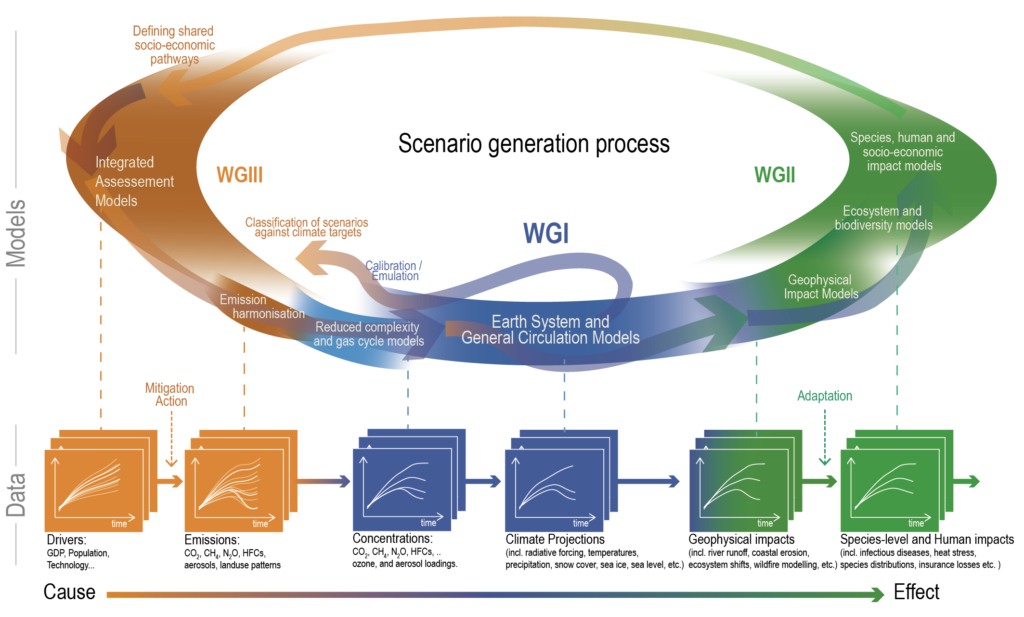
A simplified illustration of the scenario generation process, involving the scientific communities represented in the three IPCC Working Groups. The circular set of arrows at the top indicates the main set of models and workflows used in the scenario generation process, with the lower level indicating the datasets (Fig 1.27, Chapter 1 – IPCC AR6 WGI report).
THE CURRENT ESM-IAM MODELLING FRAMEWORK
The core of the scenario generation process relies on a consistent information flow between each modelling platform. The way the SSPs are processed within the model chain influences climate projections, the response of the land carbon cycle and the assessment of mitigation pathways. Therefore, enhancing the current framework, where information is translated between IAMs and ESMs, is crucial to ensure that the latest research from each modelling community contributes to our understanding of future climate change and available mitigation options.
Even in the most advanced current ESM-IAM frameworks, ESMs and IAMs operate independently, without interactive coupling or interactions (information does not follow a closed loop). This results in two largely independent information streams between ESMs and IAMs, and further implies that there are very few geophysical properties or constrains from ESMs that are accounted for in the IAM framework (except from carbon budget estimates).
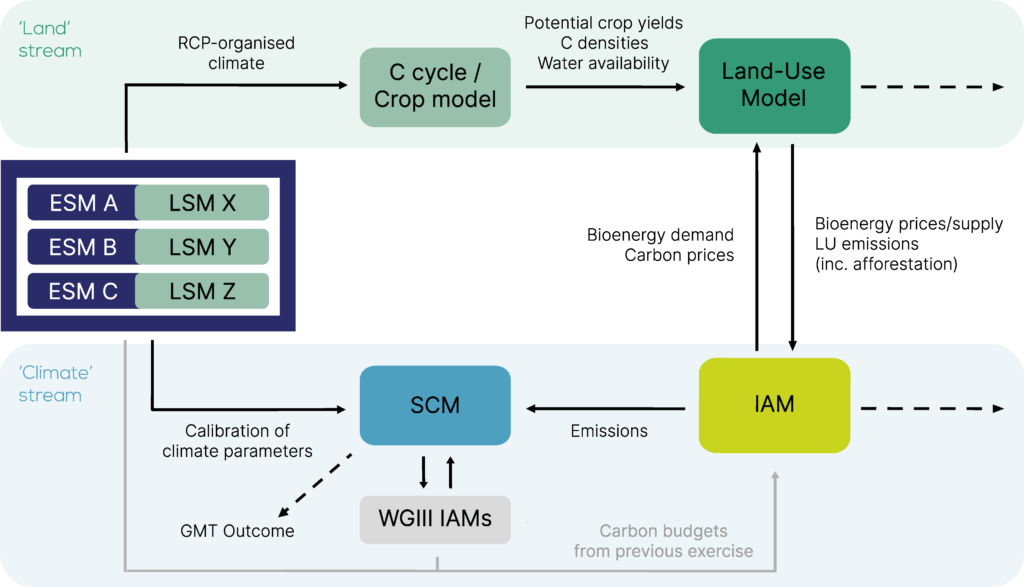
The ‘climate stream’
This is the traditional ‘one-way’ stream of information widely used today in models contributing to CMIP exercises and IPCC assessments. Different socioeconomic scenarios of the SSPs, and climate targets expressed as Representative Concentration Pathways (RCPs), can be input to an IAM, which then ‘translates’ them into GHG emission scenarios. Subsequently, an SCM is employed to ‘convert’ well-mixed GHG emissions, such as CO2 or CH4, into GHG concentrations. This is an important step, since most ESMs currently require GHG concentrations as inputs rather than emissions. For reactive short-lived substances, atmospheric chemistry models serve a similar purpose. Afterward, ESMs can utilise these different concentration scenarios to generate corresponding climate projections.
The climate parameters of the SCMs are calibrated using a combination of historical observations and the ensemble of ESMs (currently, CMIP6 ESMs), enabling the SCMs to account for some of the uncertainty present in ESM simulations. Additionally, some SCMs can provide a global mean temperature (GMT) output corresponding to each RCP. Presently, IAMs do not use this GMT information to constrain their techno-economic dynamic. They use exogenously-set carbon budgets that are still typically derived from a combination of data from WGI ESMs and WGIII IAMs (to constrain the non-CO2 contribution).
The ‘land stream’
Additional information from IAMs to ESMs primarily concerns land use, including, for example, future land management choices. While theoretically it can encompass various climate feedbacks on the socio-economic system, the current emphasis is on the carbon cycle and land use. This focus on the land sector stems from its important vulnerability to climate change and its substantial feedbacks on the climate system, but also from the technical complexity of implementing ‘downstream’ feedbacks where climate impacts human systems.
In this stream, the climate projections from different ESMs, based on various RCPs (and corresponding radiative forcing levels for 2100), serve as input climate parameters (e.g. temperature, precipitation, CO2 concentration) for a carbon cycle/crop model. This model then generates parameters like potential crop yields, carbon densities, and water availability, which subsequently drive a land-use model. The land-use model produces outputs such as bioenergy prices/supply and land-use emissions, including afforestation. These outputs are iteratively adjusted with bioenergy demand and carbon prices calculated by an IAM. At present, due to the lack of a closed loop between the two information streams, the RCPs used as input for the C cycle/crop models are based on older scenarios compared to those generated in the ‘climate stream’ by the SCM using emissions data from the IAM.
Although the ESMs employ their own Land-Surface Models (LSMs), these LSMs do not directly contribute ‘land information’ to the ‘land stream’. Currently, this role is fulfilled by another C cycle/crop model in the IAM itself, which has its own carbon cycle and feeds its results (e.g. crop yields and C densities) to the land-use model (also in the IAM). Nonetheless, the inclusion of C cycle/crop models represents a significant advancement, marking the initial step to incorporating consistent assumptions about land-use within the ‘land stream’.
While it has its limitations, the creation of a ‘land stream’, where ESM information influences changes in carbon stocks on land and can be integrated into IAMs, represents a significant improvement over previous first-order approximations.
IMPROVING THE ESM-IAM MODELLING FRAMEWORK
The inconsistencies of the framework
From the preceding sections, it is evident that several inconsistencies persist within the ESM-IAM modelling framework used for projecting future climate and land use changes, as well as for examining various mitigation pathways. These limitations are shared among all models and modelling frameworks participating in Model Intercomparison Project (MIP) exercises. In some cases, there is no climate model input to IAMs (the ‘land stream’) at all.
For the next sections, we will focus on a specific modelling framework: the Potsdam Integrated Assessment Model Framework (PIAM), which comprises the REMIND-MAgPIE IAM, the land surface model LPJml and the simple climate model MAGICC. In the scope of ESM2025 project, the ESM-IAM modelling framework includes five ESMs (that have been used for CMIP6 exercises) and respective LSMs: ICON/JSBACH4, CNRM-ESM/ISBA-CTRIP, IPSL-CM/ORCHIDEE, UKESM/JULES and NorESM/CLM5.
Inconsistencies exist through the ESM-IAM modelling chain, from the conversion of GHG emissions to concentrations, to climate outcome feedbacks influencing the land surface response, and even within the internal land surface response. For instance, when a particular scenario is input into MAgPIE-REMIND IAM and follows the entire process until a new climate output is obtained from the ESMs, the result is a slightly different scenario, although not drastically so, leading to inconsistencies between the two scenarios.
In the ‘climate stream’, the carbon budget that is computed internally by MAgPIE-REMIND is not the same that is output by the ESMs: there are uncertainties coming from (i) the CMIP6 ESMs climate outputs that are used to derive part of the carbon budgets used by IAMs and to calibrate MAGICC (the ‘translation’ of emissions to concentrations), and also from (i) the emissions and land use assumptions of the IAMs that are used to derive the other part of the carbon budgets for given mitigation targets.
Both information streams have inconsistencies in the representation of the carbon cycle in the different models, which are only indirectly included in the climate outcome assessments and carbon budget calculations. In the ‘land stream’, the LSMs of the ESMs are not used to provide ‘land information’ to MagPIE. When the ESMs are used in concentration-driven mode, they are ‘overridden’ by the LPJmL model’s assumptions. Consequently, recent advancements in LSMs of ESMs are not integrated into the simulations of potential C stocks or crop yields, which serve as input to MAgPIE-REMIND, where they translate into different carbon dioxide removal potentials (e.g. afforestation and Bio-Energy with Carbon Capture and Storage – BECCS). This further implies that the ‘land stream’ is not getting ‘climate information’ feedback from the ‘climate stream’.
In the ‘climate stream’, MAGICC, which has its own C cycle, is calibrated using a probability distribution derived from the various LSMs of the ESMs. Even though this SCM is the one model in the chain treating carbon cycle uncertainty the better, it does so in a manner that prevents the tracking of that uncertainty back to a specific LSM. This thus makes it impossible to keep this uncertainty consistent throughout the rest of the modelling chain.
ESM2025 contribution to improve the framework consistency
While uncertainties in climate and carbon cycle outputs from ESMs will always exist due to variations in how each ESM simulates the different Earth system processes, these uncertainties offer valuable insights into the works of the Earth system. The challenge within the current framework lies in the inconsistent handling of these uncertainties throughout the model chain. It is presently difficult to assess how uncertainties on one side of the model chain, like climate outputs, affect uncertainties on the other side, such as mitigation outputs. Hence, in ESM2025 project, we are trying to enhance the consistency of the ESM-IAM modelling framework by implementing a consistent treatment of the uncertainties.
One of our primary objectives in improving the consistency of the ‘climate stream’ is to provide GMT directly from MAGICC to REMIND, instead of relying on exogenously-set carbon budgets. This was previously common practice, but introduced MAGICC uncertainties that complexified multi-model comparisons, which led to a shift toward using carbon budgets. In ESM2025, we are working on fine-tuning MAGICC to better represent ESMs’ temperature calculations and to provide temperature targets to REMIND, while accounting for ESM uncertainties in a more consistent way than before.
Recent advances in the understanding of the carbon cycle have already started to benefit ESMs results. However, uncertainties in this cycle are still poorly and inconsistently accounted for throughout the model chain. These uncertainties can have significant implications, particularly in the assessment of land-based mitigation options like afforestation/reforestation or BECCS. Hence, we are working to improve the consistency of the representation of carbon cycle uncertainties across various components of the model chain through the following:
- By calibrating MAGICC’s C cycle parameters directly with ESM simulations, which will allow for the incorporation in this simple climate model of recent advances on carbon cycle modelling already implemented in ESMs. This will improve the overall consistency of the ‘climate stream’.
- By providing C stocks and bioenergy yields directly from the ESMs’ LSMs to MagPIE, which will eliminate the limitations associated with LPJmL and leverage the latest advances in ESMs’ LSMs. This will enhance the consistency of the ‘land stream’.
- By establishing a direct flow of information about carbon sinks from MAgPIE to MAGICC. This will be a significant stride toward ‘closing the loop’ of the model chain, where land carbon cycle information from ESMs’ LSMs feeds directly into MAGPIE, which can subsequently provide land-use information directly to MAGICC.
In ESM2025, we are not only working to enhance the internal consistency of the modelling framework but we are also striving to improve the ability of our ESMs to operate on an emission-driven basis, rather than concentration-driven. This transition represents a significant step towards improving the overall consistency of the ‘climate stream’ and moving closer to achieving a ‘closed loop’ in the ESM-IAM framework.
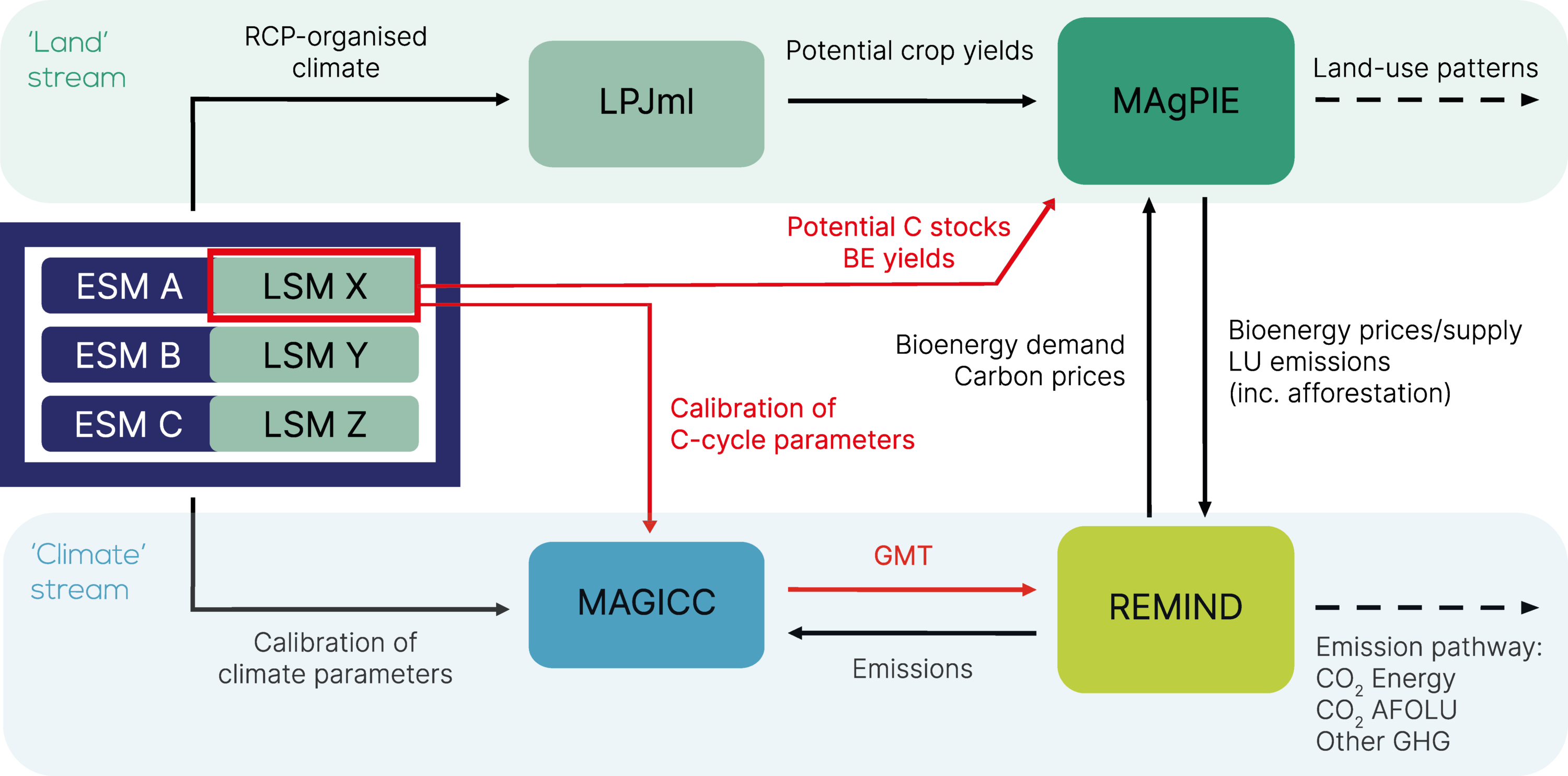
Implications for climate policy making
These advancements hold the potential for a significant policy-related outcome: a more accurate evaluation of the risks associated with various land-use management strategies, such as afforestation and BECCS, as well as the capacity of the entire land sink for carbon removal. Improving the treatment of the land carbon cycle throughout the model chain will particularly enhance our assessment of land-based mitigation options, offering robust transformation pathways that account for uncertainties in the land carbon cycle.
The new emission-driven capability in ESMs will also contribute to a better understanding of carbon cycle uncertainties and their implications for concrete policy actions, thus strengthening our comprehension of the challenges we face.
FUTURE CHALLENGES
The implementation of these advancements on the ESM-IAM modelling framework is critical for robust modelling of how land-based mitigation and carbon removal strategies form part of a wider mitigation strategy. Acknowledging that there are inconsistencies in the model chain is moving a step further in the good direction, but there is still a long way to go before achieving a fully coupled framework. Some technical improvements, like getting our assumptions on crop use consistent with those of the carbon cycle, may be implemented in the near future. However, others, such as integrating in the model chain process-level information about explicit carbon removal options, similarly to IAMs, may require a much longer timeline. This would necessitate not only process development in ESMs, but also coupling, and establishing protocols for communication between IAMs and ESMs regarding carbon dioxide removal objectives, including units, consistency, and more. This would imply a broad community discussion and collaboration. Furthermore, some researchers suggest that ‘closing the loop’ may not even be achievable with current models, and that an intermediate-complexity type of model will have to be developed to completely represent the human-climate system coupling.
However, we do know that even if the quantitative improvements prove to be limited, fostering better dialogue between the different modelling communities is a necessary and invaluable step towards enhancing the ESM-IAM framework and a better integration of the IPCC working groups. In the end, the biggest challenge lies in bringing together diverse research communities to collaborate and work on the same problem. Historically, this task has been ‘nobody’s job’, but it is now the focus of ESM2025 core theme 3 work packages, which involve scientists from the ESMs, IAMs and SCMs research communities.
Authors: Mariana Rocha (CNRM/Météo-France), Gabriel Abrahão (PIK, Germany), Thomas Gasser (IIASA, Austria) and Benjamin Sanderson (CICERO, Norway).
ESM2025 researchers working on this topic: all researchers working on Core Theme 3 «Connecting with IAMs».
